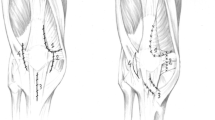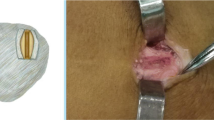Summary
Between January 1986 and August 1995, we treated 86 patients suffering from lateral displacement of the patella with arthroscopic medial tightening and lateral release after a conservative functional treatment remained unsuccessful. 49 patients were available for follow-up studies. 29 patients were treated after primary dislocation of the patella, and 20 patients after recurrent dislocations (2–20). The lateral release was performed by arthroscopy in 28 patients and in 21 patients in an open procedure. The mean follow-up time was 47.3 months. The rate of reluxation was 8 %. In the opinion of the patients, 44 (90 % of the follow-up) operations were evaluated as good/very good, the average Lysholm score was 87.3 ± 13.9. The clinical results were influenced by the point of time of the operation. Patients with monoluxation showed a lower rate of reluxation (3 % vs. 15 %) and superior functional and subjective results than those with recurrent dislocation. However, there were no significant differences between the open and closed performed lateral release. We recommend the technique presented here as a minimal-invasive method especially for patients with monoluxation of the patella.
Zusammenfassung
Zwischen Januar 1986 und August 1995 waren 86 Patienten mit Patellaluxation mit einer arthroskopischen medialen Kapselraffung und lateralem Release versorgt worden, davon standen 49 Patienten für ein Follow-up zur Verfügung. 29 Patienten waren nach Erstluxation und 20 Patienten nach mehrfachen Luxationen (2–20) operativ versorgt worden. Bei 28 Patienten erfolgte das laterale Release arthroskopisch, bei 21 Patienten offen. Die Nachuntersuchung erfolgte nach durchschnittlich 47,3 Monaten. Die Reluxationsrate betrug 8 %. Das Ergebnis war von 44 (90 % der nachuntersuchten) Patienten als gut bis sehr gut beurteilt worden, der Lysholm-Score betrug 87,3 ± 13,9. Beeinflußt wurde das Ergebnis vom Zeitpunkt der Indikationsstellung. Patienten mit Monoluxation (n = 29) wiesen eine niedrigere Reluxationsrate (3 vs. 15 %) und ein besseres funktionelles und subjektives Ergebnis auf, als Patienten mit rezidivierenden Luxationen (n = 20). Zwischen dem offenen und dem geschlossenen durchgeführten lateralen Release konnten wir keine signifikanten Unterschied feststellen. Die vorgestellte Methode stellt ein geeignetes, minimal-invasives Verfahren zur Therapie insbesondere der Monoluxation dar.
Similar content being viewed by others
Author information
Authors and Affiliations
Rights and permissions
About this article
Cite this article
Hehl, G., Rapp, F., Kramer, M. et al. Arthroscopic therapy of patellar luxation. Operative technique and clinical results. Unfallchirurg 102, 632–637 (1999). https://doi.org/10.1007/s001130050459
Published:
Issue Date:
DOI: https://doi.org/10.1007/s001130050459




